Battle of Monachia (Pacifica)
| Battle of Monachia | |||||||
|---|---|---|---|---|---|---|---|
| Part of Karnetvorian Confederate War | |||||||
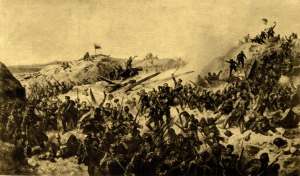 "Fall of the Central Redoubt" by Seffi All | |||||||
| |||||||
| Belligerents | |||||||
|
Allies |
| ||||||
| Commanders and leaders | |||||||
|
|
| ||||||
| Strength | |||||||
|
Total: 195,000
|
Total: 120,000
| ||||||
| Casualties and losses | |||||||
|
Total: 37,335
|
Total: 85,368
| ||||||
The Battle of Monachia was a major battle in the Karnetvorian Confederate War, also known as the War of Confederation. Occurring in February 4th, 1861, it is considered the turning point in a war that until then had been dominated by the forces of the kingdoms of Hyreil and Jetikya. In the battle, one of the biggest in history at that time, and the deadliest battle on Karnetvorian soil until 2012, the forces of the Karnetvorian League, led by Karnetian general Feodor Gerasimović and Nitraenian Crown Prince Vladimir, resoundingly defeated the Hyrellian Army of Nitraen and captured the strategic city of Monachia, the capital of the Kingdom of Nitraen, which had been captured by the Hyrelians in 1859.
Background
In the year 1861, the Confederate War between the Hyrellian-Jetikyan Coalition and the Karnetvorian League was in full swing, entering its third year. The Kingdom of Hyreil and its ally, the Kingdom of Jetikya occupied large parts of the League's Southern Colonies, and the capitals of League members Molotov and Nitraen. Two years before, the Hyrelians and Jetikyans appeared to be winning the war; however, they suffered important defeats in Endville and in Novaya Karnetia. In the former, a combined Hyrellian-Jetikyan army was surprisingly defeated by a vastly outnumbered enemy following a bloody battle; in the latter front, the Jetikyans attempted an offensive after offensive, only to be stopped by the better trained and equipped Allied (League) forces.
These gains inspired the historic Molotovgrad Conference in October 1859. There, the political and military leaders of the League and the Sedunn agreed to coordinate their advances and developed a joint strategy: they would neutralize the enemy navies and establish a blockade against the enemy (this objective was quickly met, as Karnetia, the League's de facto leader and owner of one of the most powerful navies in the world at that point, had largely accomplished it by this time), to then make two simultaneous offensives towards the enemy capitals. To this end, two large armies were formed. The first one, the Allied Army of the North, formed by Karnetian and Endvillian units, plus the Sedunnic Expeditionary Corps, was tasked with invading Hyreil; the second one, the Allied Army of the South, composed of Karnetian, Molotovian, and Nitraenian units, plus some Sedunnic volunteers, was to neutralize Jetikya. To lead the armies, the Conference appointed Major General Feodor Gerasimović (Karnetia) for the Northern Army, and Crown Prince Vladimir (Nitraen), for the Southern Army.
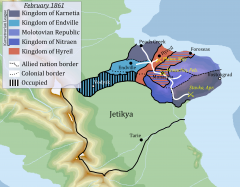
In early 1860, the Southern Army landed in Vostokgrad, Novaya Karnetia. In April, it won a decisive victory against Jetikya in the Second Battle of Stavka, expelling the latter from the Karnetian colony. Following news of this victory, the Northern Army invaded Hyreil. However, the battle that followed (the Battle of the Hyrellian Plain) was inconclusive and the League was forced to withdraw, suffering heavy casualties. Gerasimović suggested a change of strategy; he advocated capturing the Pazzini river, a crucial waterway connecting the north with the south, cutting off Hyreil's Army of Nitraen, the main enemy force, from reinforcements. Then, both Allied armies would proceed to the city of Monachia, crushing the Army of Nitraen and cutting all communications between Hyreil and Jetikya. The new plan was quickly accepted.
In July, the Army of the North began the River Campaign, slowly advancing along the course of the river towards Monachia. By this time, the Allies enjoyed both technological and numerical superiority in the area; the campaign was a tremendous success, with the Hyrelians finally withdrawing to Monachia in October. In December, the Army of the South crossed the mountains marking the border between the Karnetvorian mainland and the colonies. The Allies then decided to renew the offensive in February, to allow the armies to regroup and resupply. The day chosen was February 4th, 1861.
Sedunnic participation
When the news of the outbreak of the war reached Grovne, thousands of citizens gathered outside the Sedunnic parliament to demand that Sedunn should enter the war on Karnetia's side. The Sedunnic government had already made the decision to join the war, and king Tavtid I announced the government's decision in passionate speech to the cheering crowd. The memory of the Second Trade War of 1790 was still strong, and most officials wanted to return the needful favour of Karnetian support. Sizeable naval forces were assembled in Essela and sent for deployment in the Karnetvorian Channel, and the army prepared to initially send two infantry divisions, composing the Sedunnic Expeditionary Field Corps, commanded by General Trannienn.
The navy was not prepared for the amount of soldiers that was to be transported to Karnetia and needed almost a full year to get ready. In the meantime about 2,000 Sedunnic volunteers arranged their own transport to Karnetia and was put under Karnetian command upon arrival.
Comparison of Forces
The Allies counted with approximately 250,000 men in total, distributed as follows:
Allied Army of the North: 115,000 men
- 50,000 Karnetians (I and III Corps, the former with three divisions, the latter with two).
- 35,000 Endvillians (II and IV Corps, three and a half divisions in total).
- 20,000 Sedunners (Expeditionary Field Corps, two divisions).
Allied Army of the South: 90,000 men
- 40,000 Karnetians (I and III Corps, two divisions each)
- 30,000 Nitraenians (II Corps, two divisions)
- 20,000 Molotovians (Molotovian Expeditionary Corps, two divisions).
The Hyrelians, on the other hand, had been severely weakened by the River Campaign, and only disposed of 100,000 men, 20,000 of them Jetikyan volunteers. However, the Allied numerical superiority only became an issue at the very end of the battle, as both Allied armies arrived at different times and fought on opposite sides of the battlefield.

The League armies were equipped with the famed Kirovsky needle gun. Introduced by the Karnetians in 1860, it gave the Allies a significant advantage over their opponents; one of the first breech-loading rifles to see widespread use on the battlefield, it allowed the user to quickly fire and reload his weapon, at a time when most nations, including the Hyrelians, used muzzle-loading weapons, which took a minute at best to reload. The Sedunnic Forces used a similar rifle, albeit theirs had been adopted earlier and used a slightly different design. As for artillery, the guns used by both sides were fairly similar; muzzle-loaders, mostly smoothbore, made of bronze. The Hyrelians had more guns than the Allies, but those were often cheaply made or were obsolete models, as the Allied blockade produced a shortage of raw materials. Most of the Allied artillery was in the Northern Army's hands, as the Army of the South had left most of its artillery in Novaya Karnetia in order to make the hasty and dangerous crossing of the mountains.
Preparations and start of the battle
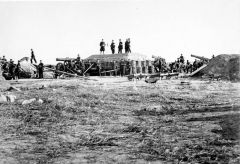
After the River Campaign, the Hyrelian Army of Nitraen was almost completely cut off. Rather than to directly engage the approaching Army of the North and challenge its superior firepower, Major General Duke Nikolay Gračanin decided to dig in northwest of Monachia, waiting for reinforcements he hoped would arrive from Hyreil. The Army of Nitraen had plenty of time to prepare its defences, constructing large redoubts in favourable positions with its flanks secured by the deep and wild Severov River. The only significant drawback was that this defensive network was situated below the hills to the northwest. Assuming the commander of the Army of the North, Major General Feodor Gerasimović, was unwilling to accept the severe losses a direct assault on Monachia would lead to and instead besiege the city, Gračanin intended to trap him between himself and the reinforcements he was hoping would arrive soon.
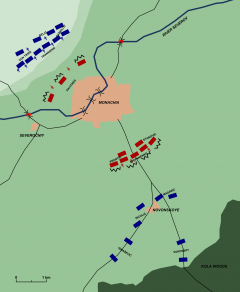
As more and more Allied troops arrived to the deployment area on the hills, they soon initiated a bombardment of Gračanin’s redoubts, aiming to gradually weaken them in preparation for a storming. This was in line with the cautious tactics Gračanin had planned for. However, Gračanin was unaware that the Allied Army of the South had turned north, discontinuing its march on the practically undefended Jetikyan capital. Leaving most of its artillery and heavy equipment behind, the Army of the South, commanded by Crown Prince Vladimir of Nitraen, was able to force its transport towards Monachia. The rapid redeployment and transportion of the Army of the South came as complete surprise to Hyreilian command, arriving weeks before the most conservative estimations. The possibility to defend Monachia’s southern flank was limited due to the open fields around village Novonskoye, but construction of new redoubts was undertaken. Gračanin’s only hope to avoid a hopeless two-front siege was to repel the Allied Army of the South. Still hoping Gerasimović was unwilling to attempt a direct assault on Monachia and the northern redoubts, he moved all available forces to the southern redoubts, leaving the I Corps to defend the northern flank (about a third of his forces). He also destroyed the bridges outside the city.
In a daring move, Gračanin then waited with his counterattack until the Army of the South had fully deployed, hoping to trap it between his redoubts and the forest, and completely defeat it, and thereby removing the risk of further attacks on Monachia's southern flank. The battle started as the Hyrelian artillery initiated a heavy barrage on the Southern Forces' flanks to provide cover for the infantry brigades to begin a double envelope.
Novonskoye Fields
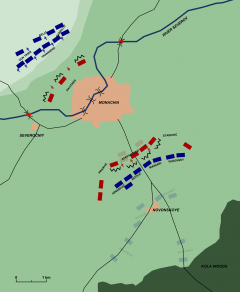
Gračanin’s startegy soon proved to be sound; the Hyreilian artillery successfully pinned down Army of the South's flanks, and the redoubts halted the Army's advance. However, the pincer movement was only a partial success, as there were not enough men to complete the manoeuvre, but the battle was locked in favour of the Hyrelians.
Taking heavy casualties, Crown Prince Vladimir realized the difficult situation they were in. He first planned to assault the redoubts to break the deadlock, but was advised against it by his staff, fearing that would have allowed a complete encirclement of their forces. They decided to request the Army of the North to attempt an early breakthrough of the northern redoubts, and prepared an orderly retreat towards the forests.
Northern redoubts
Gerasimović and his staff had observed the battle on the Novonskoye fields from the Monachia Hills. They soon realised that the Army of the South would be repelled, or worse, completely defeated. When they saw the signal to immediately come to its aid, they first responded by intensifying the bombardment. Using all available pieces, the allies initiated an unprecedented barrage while the infantry divisions prepared to storm the redoubts.
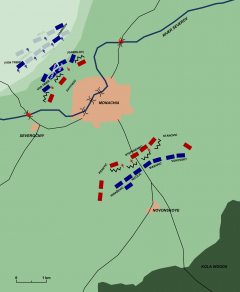
Being on high ground, the Allied artillery was able to take out the majority of the remaining relatively unprotected Hyrelian artillery. While the barrage continued to have a good effect on the redoubts, it was crucial to get to the southern fields as soon as possible, and a rushed order was given to storm the redoubts. Keeping a few brigades in reserve, Gerasimović concentrated his attack on the central redoubts to attempt a breakthrough there.
As the Allies advanced in disciplined formations, the shocked Hyrelians were soon able to offer increased resistance. Nikita Voronov, a Hyrelian soldier, later noted in letter that the hillside that had been so green and lush moments earlier turned completely blue and grey as the enemy advanced on our positions. We could not believe it, but we could shoot with our eyes closed and still hit a foe with every single bullet
.
The Allies began to suffer escalating casualties, being extremely exposed on the open fields. However, as they arrived at the redoubts, the breech-loaded rifles soon gave the Allies the upper hand, allowing them to reload and fire several times before the Hyrelians had reloaded.
Allied break-through and retreat
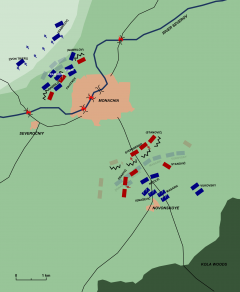
Meanwhile, the Allied Army of the South had suffered great losses and was in full orderly retreat towards the Kola Woods. The II Corps, composed of mainly Nitraennian soldiers and commanded by Major General Count Aleksey Nikolić, was tasked with covering the other retreat of the other divisions. With great cost, they managed to repel several Hyrellian attempts at attacking the retreating forces in their back, again thanks to their superior rifles.
The undermanned Hyrelian redoubts were unable to repel the advancing Allies. Soon the central northern redoubts fell, which allowed the Army of the North to send reinforcements through Monachia. The citizens of Monachia helped the Allies to find their way through the streets, and even managed to prevent the last major bridge from being destroyed by the Hyrelians. Gerasimović decided to send the bulk of his forces through the city, leaving a few brigades to guard the remaining Hyrellian redoubts. After about two hours, five infantry divisions had rushed through the city and was assembling just south of the city.
Fall of the southern redoubts
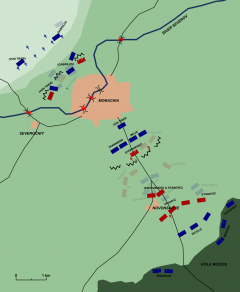
Most of the Hyrelian forces at the southern redoubts had been sent out in pursuit of the Army of the South, which left the redoubts virtually defenceless. The redoubts surrendered under fierce fire, and most of the Hyrelian artillery there fell into the hands of the Allies. However, the guns were never fired, as to avoid alerting the Hyrelian forces on the fields, which were unaware of the latest developments.
Meanwhile, the Army of the South had reached the woods and the relative safety there. Gračanin soon found himself exposed and caught in the fire out on the open fields. He therefore ordered his divisions to push the Allies further into the forest. The effective fire from the Allies made his progress slow, and he had still not received any reports on the fall of the redoubts.
Encirclement of the Army of Nitraen
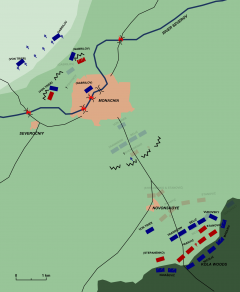
The Hyrelian charge against the forest line had been stopped by the defenders. Their situation soon grew desperate as the Army of the North appeared in their rear, completing their full encirclement. After a shorter exchange of volleys, Gračanin saw it necessary to surrender to save his army from a virtual massacre. Fighting at the northern redoubts continued until Gračanin was escorted there to give the order for them to surrender.
Aftermath
The Battle of Monachia is considered to be the turning point of the war. Following the battle, Hyrellian power in the area was completely shattered. It became unable to maintain the occupied areas under its control, and the few Hyrellian units still remaining in Nitraen escaped to Hyreil. King Constantine of Nitraen made a triumphal entrance in his regained capital two weeks after the battle, receiving a rapturous welcome from the city's inhabitants. General Gerasimović, Crown Prince Vladimir, and the Sedunnic General Trannienn, among others, would receive the Karnetian Order of Merit for their actions during the battle. Additionally, Gerasimović would be posthumously promoted to General of the Army, the highest rank in the Karnetvorian Army post-unification (equivalent to Field Marshal in other armies) in 1885.
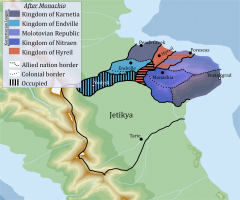
Besides expelling the Hyrelians from Nitraen, the battle also neutralized any Hyrellian threat to the southern colonies: the Nitraenian colony of Izpania was fully liberated within days of the battle. Also, the Hyrellian province of Valkaria, cut off from the rest of the country, surrendered to the Allies.
In the end, the River Campaign, which culminated on the Battle of Monachia, was an unparalleled success. After its conclusion, the Allies occupied a third of Hyreil, including its southernmost province, Valkaria, liberated Nitraen and Izpania, and caused tremendous losses to both Jetikya and Hyreil, the latter being unable to replace them. However, Hyreil still occupied half of Molotov, and Jetikya, which managed to reorganize what was left of its army due to the Southern Army's move to Nitraen, still had some strength left. The war would last another two years; Hyreil surrendered in May 1862, and Jetikya followed suit in January 1863. Finally, in September of that year, the Karnetvorian states signed the Acts of Confederation, unifying all of them into the modern Karnetvorian state.
Casualties
Both sides suffered enormous losses. However, although the number of casualties on both sides is similar, the Hyrellians lost an entire army in the River Campaign and the subsequent battle. Hyreil, struggling with a naval blockade and a war on multiple fronts, could not replace its losses in men or equipment. The Allies, especially the Karnetians, although suffering a significant number of casualties in the Hyrelian attack on the Novonskoye Fields and the assault on the redoubts, were able to replace their losses.
The approximate numbers of casualties are as follows:
Allied Army of the North: 16,950
- 6,650 killed
- 7,883 wounded
- 2,417 missing
Allied Army of the South: 20,385
- 6,795 killed
- 7,996 wounded
- 5,594 missing
Allied Total: 37,335
- 3,445 killed
- 15,879 wounded
- 8,011 missing
Hyrellian Army of Nitraen: 40,502
- 12,639 killed
- 14,670 wounded
- 10,072 captured
- 3,121 missing
Legacy
The battle holds an important place in the Karnetvorian national consciousness. Even if joint armies had been organized before, it was the first time all the armies of the different states were brought under a single command, essentially the first "truly" Karnetvorian army. To Karnetvorian nationalists of the time, it reinforced the idea that all the Karnetvorian states were part of a single nation. Since 1919, the date of the battle, February 4th, is commemorated in Karnetvor as Armed Forces Day.
The battle also helped cement the lasting friendship between Karnetvor and Sedunn. Sedunn had had a treaty with Karnetia since the late 18th Century, and its participation in the war in general and the River Campaign in particular, convinced the government of United Karnetvor after the war to renew the Alliance, now called the Sedunno-Karnetvorian Alliance. It would last until 1915, and after a century of animosity, it would be formally restored in 2017.
In Sedunn, there is a popular tradition which originated in this battle. After the end of the war, the Sedunnic soldiers returning home brought with them the recipe for tvorožniki, which is a traditional Karnetvorian dish with quark pancakes, served with sweet toppings. The dish, now known is Sedunnic as Tevoro, gained popularity, and became a symbol of the soldiers' sacrifice and the Karnetvorian friendship. Because of that, February 4th is unofficially commemorated as Tevoro'etunn, or Pancake Day; it is celebrated by serving the dish.
Gallery
-
Sedunnic artillery commencing assault fire before the charge against the redoubts.
-
Formations from the Army of the North advancing on the northern redoubts.
-
Maj. Gen. Nikolay Belić commanding his troops at the redoubts he and Gen. Trannien stormed. To the left, Sedunnic soldiers carrying wounded soldiers away from the battle.
-
The Army of the South defends itself against the Hyrelian counterattack.



